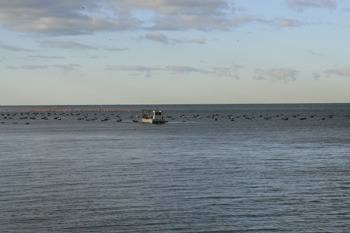
Originally published on Greenaction Transnational’s website, in Italian: “Un mare di veleni”
***

A SEA OF POLLutiON: EMERGENCY IN THE GULF OF TRIESTE.
HEAVY METALS, DIOXIN, AND TBT FOUND IN MARINE LIFEFORMS.
Northmost Adriatic sa, Gulf of Trieste: an area severely polluted.
This narrow basin, shared by four Countries (Italy, the Free Territory of Trieste, Slovenia, and Croatia) is a very urbanized environment with many production areas. There are factories, mariculture, and fishing, but also nautical and seaside tourism, and port activities. Including lots of oil traveling by sea, off to the SIOT, the Mediterranean’s main oil terminal (international Free Port of Trieste).
Untreated sewage (the European Commission opened an infringement proceeding against Italy because of Trieste’s flawed STPs), the outflow of the Isonzo river’s polluted water (mercury, from Slovenia’s Idrija mines), and decades of maritime and coastal landfills stretching from Grado and Muggia. All of this has severely compromised the narrow Gulf’s the fragile ecosystem.
The few surveys on this pollution are absolutely not enough to understand the seriousness of what, regardless to that, is an international environmental disaster, still, they are enough to frame a situation in dire need of a prompt, effective solution.
For instance, pollution doesn’t come with just economic side effects (on tourism, fishing, bathing). It has severe consequences on public health. How many people are exposed – either directly or indirectly – to this polluted sea of poison? Certainly many, considering the tourist value of this littoral.
In the present-day Free Territory of Trieste alone, coastal landfills stretch, almost uninterrupted, from Barcola (near the Miramare natural reserve) to the border with Slovenia. They are both in tourist areas and in port areas.
On top of one of the biggest costal landfill, the Barcola embankment, there are nautical, leisure time, even bathing resorts.
For instance, in Muggia, someone is attempting to open a big seaside resort with many other ancillary services on one such landfill. The landfill faces mussel farms, with animals that absorb the poisonous seawater only to return it all to the customers, in the shape of mussels contaminated with dioxin, heavy metals, hydrocarbons.
The Livorno Inter-university Center of Marittime Biology and Applied Ecology ecotoxicological’s survey about the Gulf of Trieste – Barcola embankment (in Italian; LINK) perfectly shows how dangerous the pollutants are.
The survey in the Barcola embankment/maritime landfill and other parts of the Gulf of Trieste confirms the contamination of maritime organisms. The same ,ussels and fish that ends up in food markets.
It results that there are high concentrations of heavy metal (cadmium, chromo, copper, vanadium, zinc, nichel, mercury, lead, arsenic) and TBT (tributylin) in gobies and in mantis shrimp, as well as in mussels. The contamination is very extended. The “Trieste sample” reveals high levels of poison.
Translated from blog “Ambiente e Legalità” – “Environment and Legality” by Roberto Giurastante
